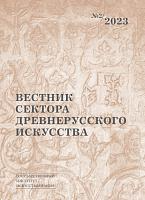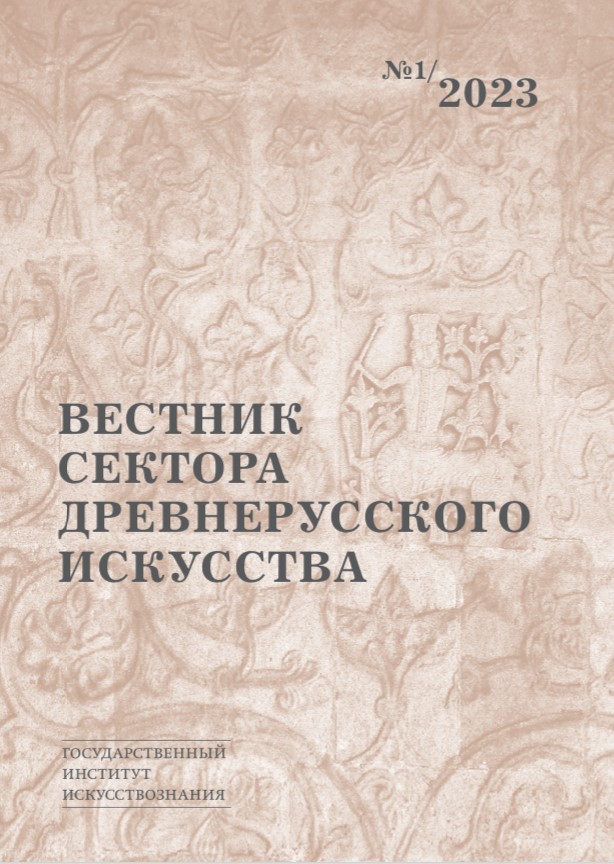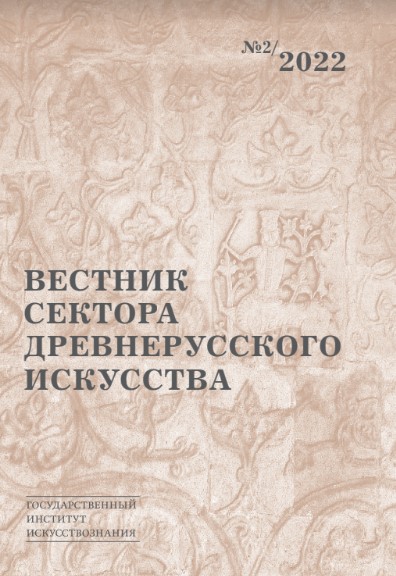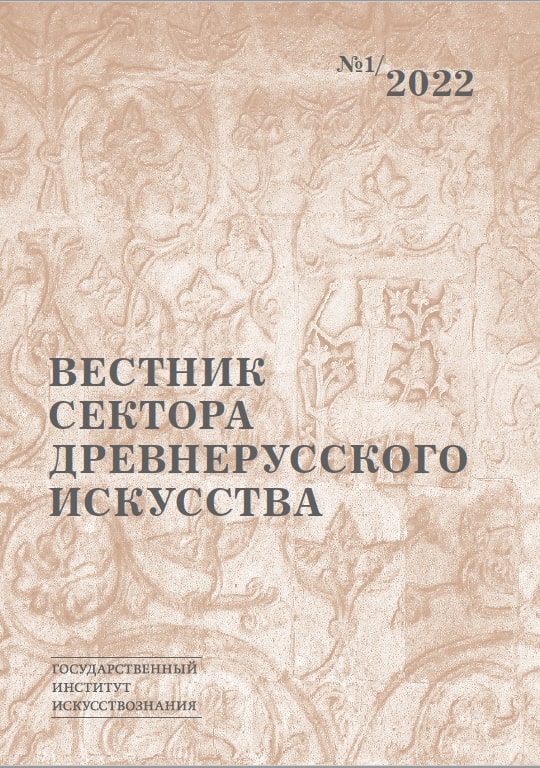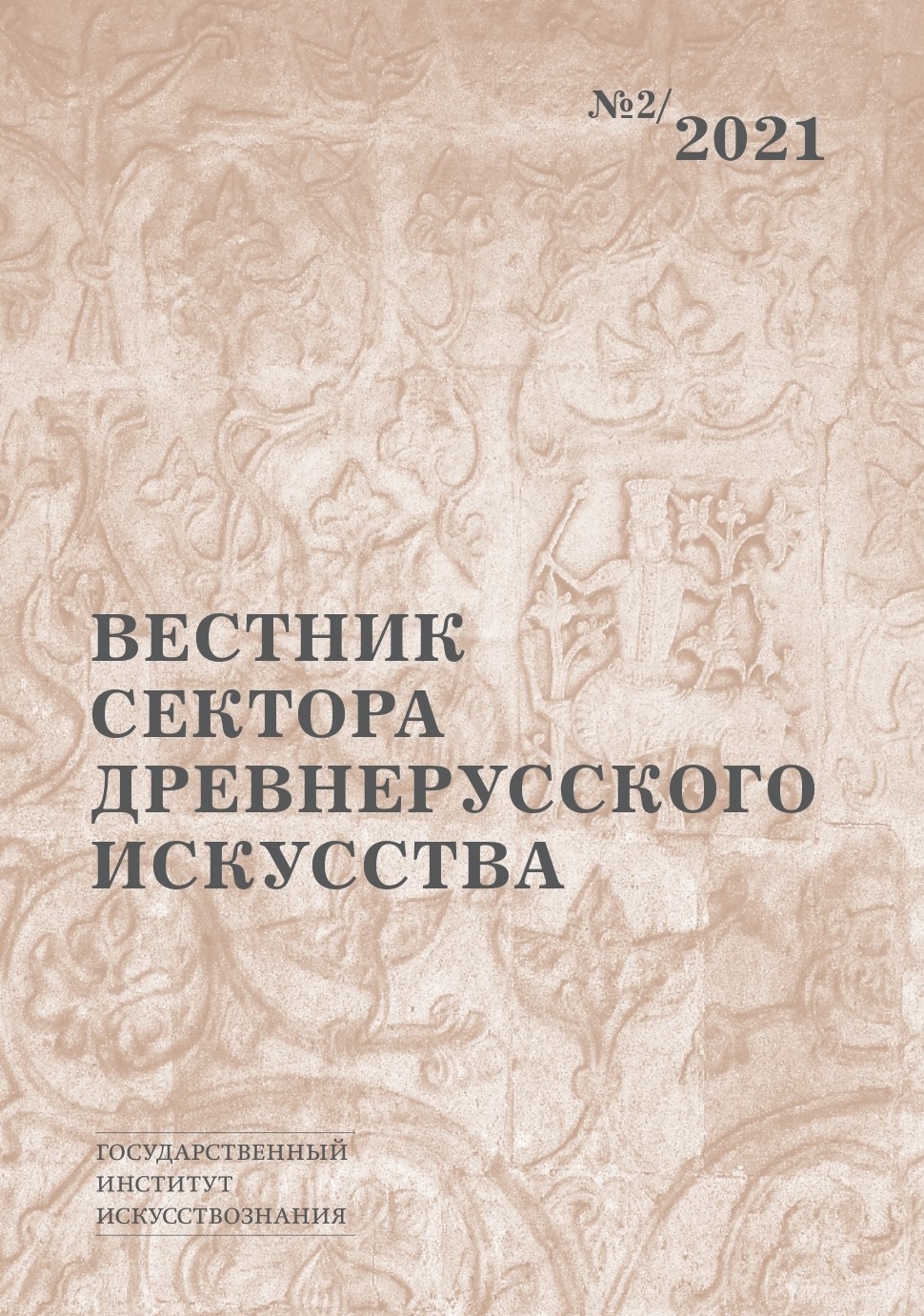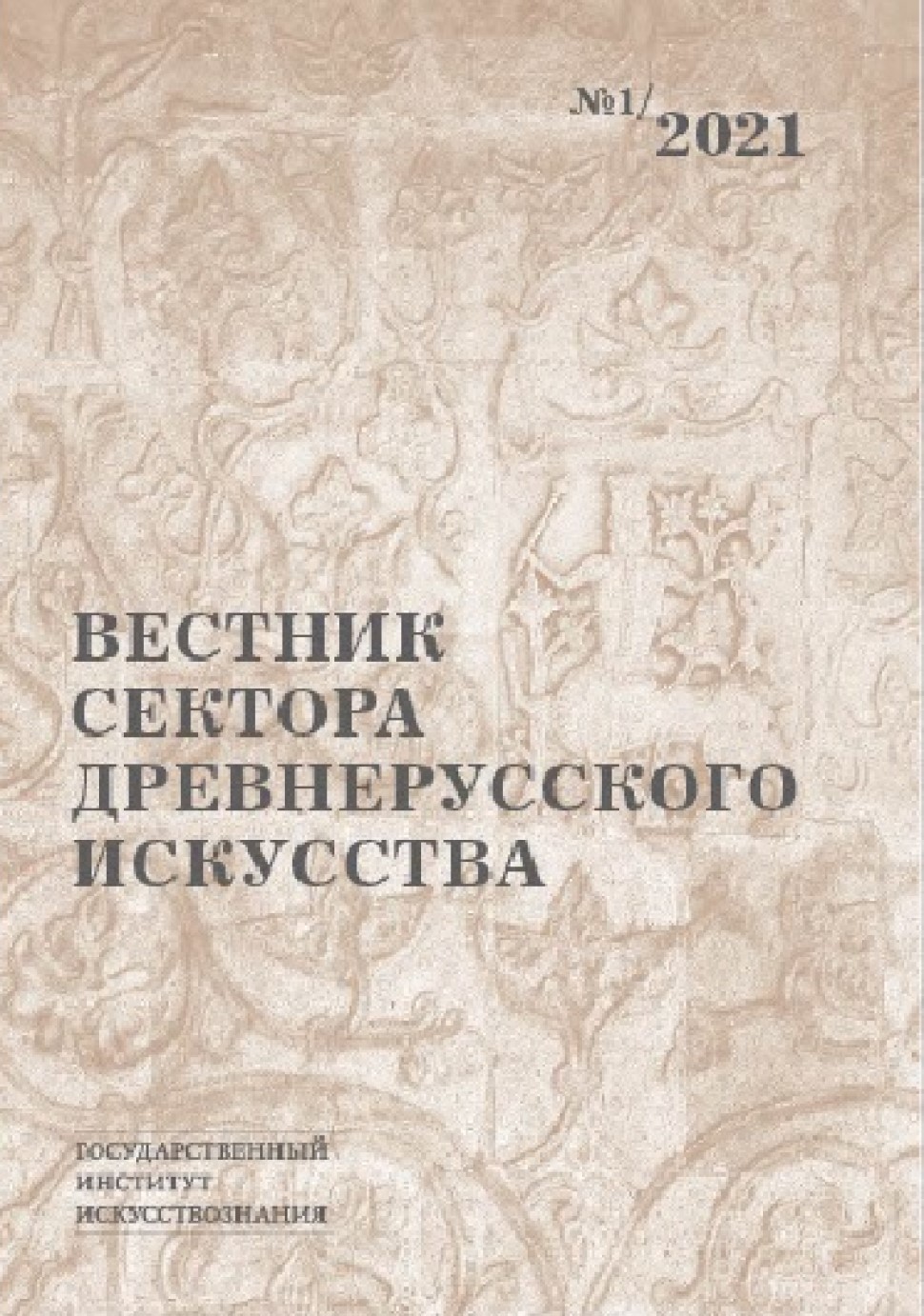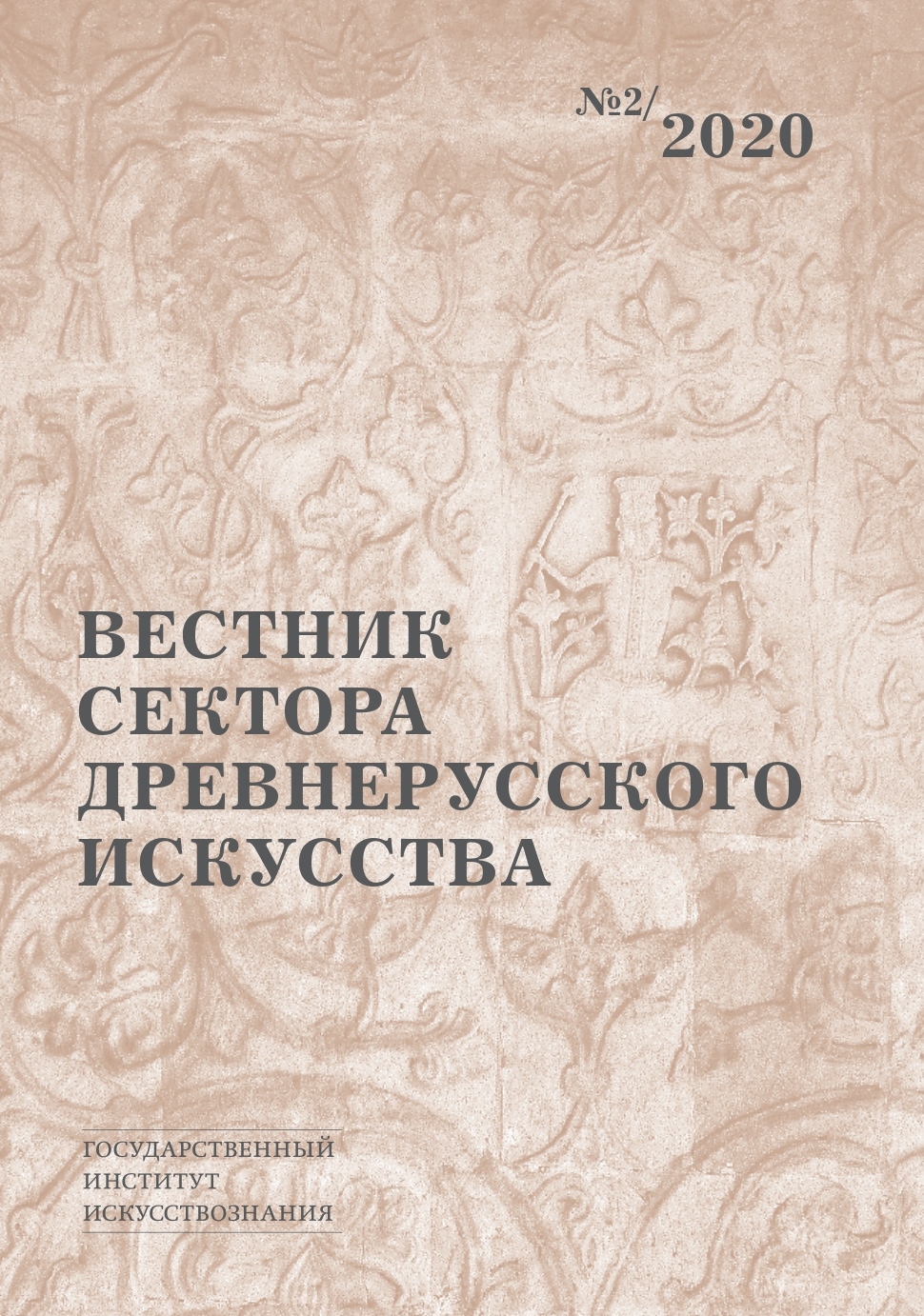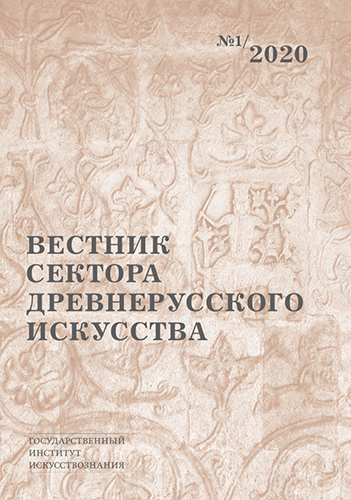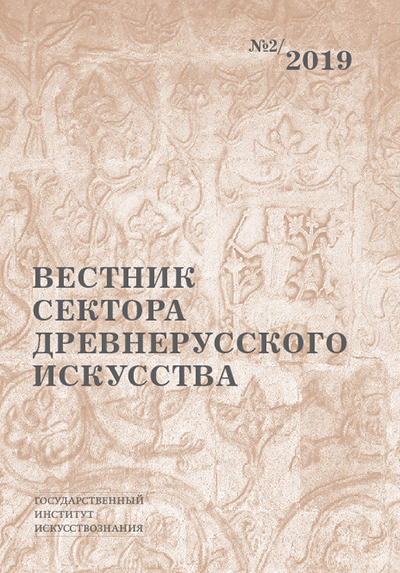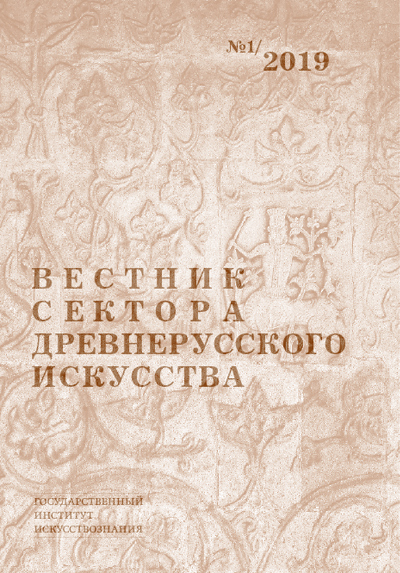2023 ¹ 1
Articles
AbstractOne of the least studied pre-Mongolian Russian monuments — the image of the Mother of God of Tenderness, which came to the Russian Museum from the collection of N. S. Bolshakov, lost information about the origin and, according to legend, was brought from Staraya Russa. The iconography is distinguished by a rare variant with a highly raised figure of Christ and an additional ubrus on the head of Mary, apparently reflecting the special veneration in Veliky Novgorod of the Blachernae relics of the Virgin's veil and the skufia. The manner of painting with the widespread use of tin for the background, fields, clothes has no analogies, but fits into the technological features of icon painting of the 13th century, when this metal began to be widely used, replacing silver and gold with it. The artistic style of the icon continues the traditions of late Komnenos expressionism and finds close parallels in the painting of the Church of the Transfiguration of the Savior on Nereditsa in Novgorod (1199), both in the imagery of faces and in the manner of execution, which confirms its Novgorod origin. However, many features of the master's art, including iconographic signs, testify to the creation of the work later — at the beginning — in the first decades of the 13th century, when significant changes occur in the spatial, coloristic and emotional solution.
Keywords
Icon, iconography, icon painting technique, Veliky Novgorod, 13th century, The Mother of God of Tenderness, artistic style, State Russian Museum.
Abstract
A small icon of Mother of God of Tenderness in a silver frame (Museum of Sergiev-Posad) was mentioned by researchers as a replica of the Virgin of the Don. Actually it differs from that iconography with some important details. This version represents the Mother of God in motion, carrying the Child as in the composition The Presentation of Christ into Temple, which always contains connotations on the Passion of the Lord. Expression shown through a dynamic composition, contrasting light and shade painting of faces, previously forced researchers to associate this style with the school of Theophanes the Greek. The analysis of the artistic features of the icon and the stylistic analogies allows us to attribute it to Moscow tradition and to date back to the particular phase of the Late-Palaeologan art of the 1410s – 1420s.
Keywords
Mother of God of the Don, Mother of God of Pochaev, iconography of Mother of God, Trinity Lavra of St. Sergius, Late-Palaeologan Art.
Abstract
The iconostasis of the Trinity Cathedral of the Trinity Lavra of St. Sergius, in which the icons of Andrei Rublev have been preserved and for which the famous "Trinity" was painted, is one of the most famous and at the same time little studied picturesque complexes of medieval Russia. The main attention has always been paid to the icons of the three middle tiers. The sovereign tier and the icons in it, known from monastic inventories, attracted attention to an incomparably lesser extent. The temple images, painted directly for the iconostasis and forming its basis, were supplemented over time by other icons that entered the monastery. According to the Inventory of the Trinity-Sergius Monastery in 1641, in the sovereign tier of the iconostasis there were cell icons of St. Sergius Radonezhsky. On the right, near his shrine, there are royal contributions and prayer icons. Icons depicting patron saints of the royal family were placed opposite the eastern pillar. The purpose of the work is an attempt to reconstruct and identify icons of the sovereign tier of the iconostasis of the Trinity Cathedral in accordance with the Inventory of 1641.
Keywords
Trinity Cathedral, Trinity Lavra of St. Sergius, icon, iconostasis, sovereign tier, icons, the Inventory of the Trinity-Sergius Monastery in 1641, reconstruction
Pavel Aleshin. New Information about Aleviz Fryazin (According to the latest Italian historiography)
Abstract
The article analyzes new archival sources published by the Italian historian G. Sironi in 1993 concerning the biography of Aleviz Fryazin in the context of the controversy about the name and origin of the master and in the context of his activities in Russia. Russian translations of these sources are given in the annex.
Keywords
Aleviz Fryazin, Aloisio da Carcano, Aleviz Novyi, Italian architects in Russia, Moscow Kremlin, Renaissance
Abstract
The article attempts to verify the information about the construction in the Vozmitsky Monastery in the middle of the 16th century. Based on the repeated reading of the sources, a reliable chronological outline of temple building in this monastery is built. Sources that are actually not related to the construction and decoration of the Cathedral of the Nativity of the Virgin are taken out of the boundaries of the problematic. The widespread opinion in art history literature about the connection between the construction and painting of the cathedral church and the ktitorship of the princes Staritsky is refuted.
Keywords
Russian architecture of the 16th century, refectory, cathedral, princes Staritsky, Principality of Volotsk, Volok on the Lama, altar cross, church chronicle
Abstract
This work, using as example the telling case of the naming of the member of the Golovin noble family, describes the general principles of the selection of two secular Christian names for the same person and discusses the possibility of the interdependence of these two anthroponyms. This work demonstrates to what extent the names were determined by the date of the birth of the child, as well as notes the general role of the calendar in personal piety of the people of the Russian Middle Ages. Particular attention is paid to the figures of namesake saints, who become the personal heavenly patrons of the named ones and the icons associated with the birthday of a particular person.
Keywords
pre-Petrine Russia, historical onomastics, secular Christian double naming, the choice of name, the cult of patron saints, church calendar, icons, Holy Maccabean Martyrs and their teacher Eleazar, baptism of Rus’, prince Vladimir the Saint, Golovin family
Abstract
The image of St. John the Baptist in the wilderness with wild beasts appeared in medieval Russian art in the second half of the 16th century, during the reign of Ivan IV, when the special veneration of the prophet as a saint patron of the tsar brought to life a lot of new versions of his iconography. The emergence of this subject in medieval Russian art was preceded by a long tradition of its existence in the fine arts of medieval Europe. Formed in the Romanesque art of the 13th century, the image of John the Baptist with animals was one of the iconic subjects of the art of Western Europe, associated with the activities of mendicant monastic orders, especially the Franciscans and Benedictines, who revered John the Baptist as the founder of ascetic monasticism. The image of John the Forerunner with beasts was compositionally variable and could carry a different semantic load, including due to the developed and multi-valued symbolism of the bestiary characters. This led to its popularity in European art of the 14-16th centuries. The appearance of this iconography in Russia was the result of the adaptation of the Western European prototype. Its assimilation fits into the mainstream of the development of post-fire art of the epoch of Ivan the Terrible, which was significantly influenced by Western European art, as has become known through recent research.
Keywords
Old Russian art of the 16th century, the era of Ivan the Terrible, iconography of St. John the Baptist, John the Baptist with the Beasts, bestiary
Abstract
In 2019 an icon inscribed with “Rakh the Good Thief” became part of the Museum’s collection. The panel most likely served as the northern door of an iconostasis as signs of its former exploitation clearly prove. The stylistic features of the icon hint that it may belong to the group of icons from the Church of St. Nicholas in Volosovo (a village in the Kargopol District of the Arkhangelsk Region), dating to the last third of the 16th century. The surviving 16th century icons from Volosovo could have been painted around 1576, when the newly built wooden church was consecrated. Of all extant icons from Volosovo, the image of the Apostle Paul (now in a private collection), the Apostle Peter and Christ Enthroned (presently in The Arkhangelsk Regional Museum of Fine Arts), and the Martyr Laurus (The Museum of Icons in Recklinghausen), from the Deesis tier are apparently the most similar to the depiction of the Good Thief and were definitely painted by the same hand.
Keywords
The Good Thief, the Door of the Iconostasis, Wooden Architecture, Deesis, the Church of St. Nicholas in Volosovo, Kargopol, Vologda
Abstract
The article presents new data on the history of seven manuscripts from the collection of the Russian Archaeological Institute in Constantinople, received in 1931 by the Library of the Academy of Sciences: RAIK 42, 51, 77, 113, 116, 125, 164. On the basis of Greek sources and the identification of the library’s seal, it is concluded that these manuscripts belonged to the “Ephoria of the schools of Larissa” in 1872 and were subsequently acquired by RAIK members or their unknown intermediaries.
The seals found in RAIK 51 and 113 are previously unknown evidence of their existence in Larissa after the destruction of the library of the Holy Trinity (or St. Dionysius) monastery on Mount Olympus.
Keywords
Greek manuscripts, library’s seals, Monastery of the Holy Trinity, Monastery of St. Dionysius, Olympus, Lithochoro, Larissa, Thessalonica, Russian Archaeological Institute in Constantinople
Abstract
The article is devoted to the analysis of three sepulchral palls of the 17th century from the collection of the Moscow Kremlin Museums associated with the decoration of the tombs of the Rurikovich tsars Ioann Vasilyevich IV and his sons Tsarevich Ioann Ioannovich and Tsar Feodor Ioannovich. The article analyzes the texts embroidered on the borders, including a search for the literary source of the text on the pall of Tsar Fyodor Ioannovich. The analysis of pictorial plaques is carried out – their composition, iconographic program, stylistic features. Special attention is paid to the chased plaque with the image of the Holy Great Martyr Theodore Stratilat, the patron saint of Tsar Feodor Ioannovich. The alleged dating of plaque is the second half of the 16th century.
Keywords
Russia, 16th century, Archangel Cathedral of the Moscow Kremlin, court workshops, cathedral sacristy, pall, precious pictorial plaques.
Discussions
Abstract
The article is devoted to the analysis of restoration materials, which resulted in the modern appearance of the Cathedral of the Spaso-Prilutsky Monastery. As a result of the study, the authors come to the conclusion that in the 1960s the hypothetical reconstruction, realized in nature, distorted the appearance of the monument of the 1530s–1540s, which is unique for Lake Beloye region. The article demonstrates fallacy of the idea that in the volumetric-spatial construction of the cathedral a combination of the traditional for this region completion with multi-row kokoshniks with capital five-domes was used. In fact, the cathedral had a composition of facades typical of cathedral construction in the early 16th century. The overlap of this temple with barrel vaults with merged girth arches was unique, which is not typical for cathedral churches of the first half of the 16th century.
Keywords
Vologda, Spaso-Prilutsky Monastery, Russian architecture of the middle of the 16th century, the chartered diploma, cathedral construction, barrel vaults with merged girth arches.
Publications
Vladimir Sarabyanov. Monuments of the Snetogorsk Monastery according to the inventory of 1584–1588
